Devil Survivor 2: Record Breaker 3DS Review: Cruel Angel's Thesis
An overlooked RPG gem becomes bigger and better on 3DS: More content, more conflict, more characters... and so much more anime.
This article first appeared on USgamer, a partner publication of VG247. Some content, such as this article, has been migrated to VG247 for posterity after USgamer's closure - but it has not been edited or further vetted by the VG247 team.
Jeremy Parish, Primary Reviewer
The Devil Survivor series has always been the most anime of all Shin Megami Tensei games... which is really saying something, considering this is the same franchise that gave us Persona 4.
2011's Devil Survivor 2 for DS felt particularly anime-like. And it's not just because of the outlandish character designs by manga illustrator Suzuhito Yasuda, though those certainly helped. Devil Survivor 2 didn't just look the part, it played it, too; its story essentially reinterpreted the standard MegaTen "end of days" themes and order/chaos/neutral morality paths as seen through the lens of Neon Genesis Evangelion. Not that Evangelion's influence is particularly unique within video games — the show has roughly the same footprint in Japanese nerd culture as Star Wars — but DS2 took its influence in a slightly different direction than most.

Rather than take from Evangelion the giant robots or depressive teens or long probing questions about personal identity and worth whose answers determine the fate of the very world, DS2 went with the more cosmic angle: Massive, otherworldly invaders who have launched a sequence of attacks on Japan in order to determine the value and fate of mankind. Everything else plays out more or less as usual for MegaTen, from the moral alignment system to the demon summoning and fusion, but the obvious influence behind the story's inflection point reverberated throughout the entire game.
Record Breaker, the long-delayed 3DS remake of Devil Survivor 2, doubles down on the anime. It adds in voice acting, a new (and presumably merchandisable) female character, and flexible difficulty settings for the sake of more casual players. Actually, that's not entirely true; the lower difficult option doesn't dumb down the game so much as make it less infuriating. DS2's cartoon aesthetics may have suggested a more kid-friendly take on the MegaTen franchise, but its difficulty level belied that illusion of approachability. It was wicked hard at times, with the battles against its Evangelion Angel analogues (the powerful alien Septentriones) proving particularly vexing. Record Breaker allows you to toggle difficulty on the fly between the original soul-crushing level and a more manageable state. The bigger battles still take some effort, but you're less likely to spike your 3DS in a fit of rage now — you can simply reduce the difficulty setting if you hit a wall, then return to the harder difficulty afterwards.
Still, these tweaks alone wouldn't justify the price of a remake of a four-year-old DS game, especially not at Atlus' premium price. The real meat of Record Breaker comes in the form of a second story mode that follows after the main game: A second series of battles against a new threat called the Triangulum. While this added mode isn't the size of the original campaign — as the name suggests, the Triangulum consists of three invaders versus the Septentriones' seven — it's still far more substantial than a mere bonus. It essentially adds an extra 50% to the game.
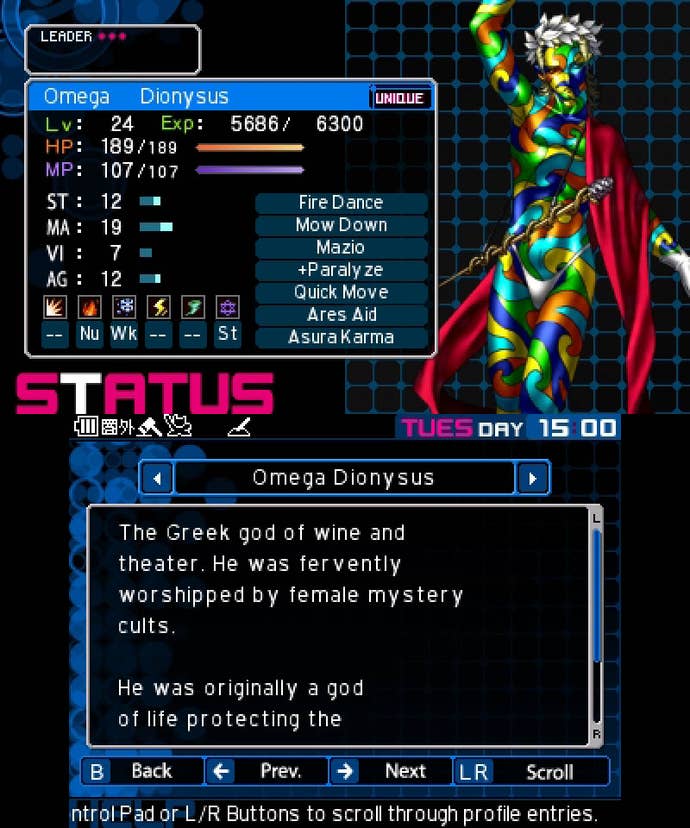
The Triangulum Arc works more or less like an abbreviated version of the main game. Many of the initial plot beats remain the same, from the way the main cast is drawn into the story upon receiving a bizarre phone app that warns them of their friends' deaths to the role of the mysterious JP's paramilitary group. But the similarities to the earlier story serve as the central mystery of the story, since (spoiler alert) the "canonical" ending to the main quest was to prevent an alien attack in the first place. As before, you can summon demons, hire new demonic companions at auction, and fuse your summoned companions into new forms in the Cathedral of Shadows. And, as in the main game, the plot unfolds across Tokyo and Japan in something akin to real-time as you take actions that count against the clock across several days.
On the other hand, the new mode assumes you've played through the Septentrione Arc and doesn't waste much time getting you up to speed; your heroes begin the adventure at level 20 with much higher-level demons than the usual fodder like Fairy and Kobold. It also takes less than an hour to acquire your full suite of support abilities, dropping you quickly into the game after a relatively light setup. From there, you're off to the races, dealing with powerful invaders and terrestrial marauders alike... and, of course, all the demons they command.
And oh, is it ever-so-anime. If Devil Survivor 2 owed a creative debt to Evangelion, Record Breaker would be the equivalent of Evangelion's "Rebuild" movies: Largely identical for the most part right up until the end... at which point it takes a huge swerve and goes in a completely different direction. The Triangulum Arc is a lot like Evangelion 3.33 in that everything feels familiar but wrong, with the heroes going up against even greater stakes than before.
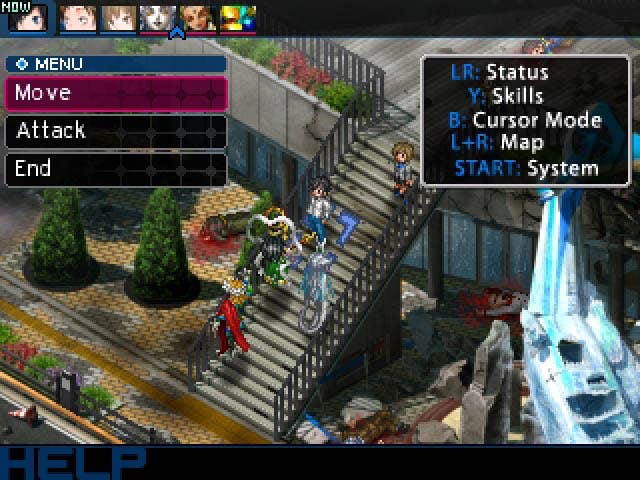
Despite the narrative convolutions, it's still Devil Survivor 2, which means it plays out as an odd hybrid of tactical RPG, first-person dungeon-crawler, and Pokémon. Rather than control a single party of demons, you deploy four groups of three warriors and determine their placement around the battlefield, one turn at a time. I dinged the original 2011 version of Devil Survivor 2 for being "more of the same," but after revisiting the game I feel the need to walk that opinion back. It puts well-worn MegaTen principles to use, yes, but despite the fact that Atlus has produced dozens of RPGs with these same demons and skill trees, the Devil Survivor titles still stand apart from the rest of the series by introducing such scale and complexity to combat.
You're fielding as many as a dozen characters at a time, two-thirds of which are demons whose skills and capabilities you've crafted yourself through auctions and fusions. There's a tremendous amount of strategic variety at play during combat, which accounts for much of what makes the game so notoriously difficult: Certain battles seem designed around specific builds. When your demon army doesn't fit the designers' expectations, you may need to invest tons of repetitive combat into rebuilding your team to fit the game's expectations. The flexible difficulty goes a long way toward mitigating the frustration of running up against one of these dead ends... though of course the easier difficult mode is entirely optional, so it doesn't undermine the integrity of the game.
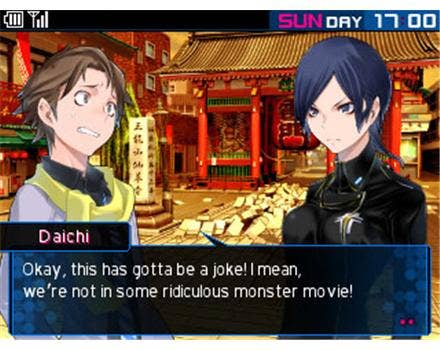
Mike Williams, Second Opinion
Unlike Jeremy, I'm coming into this whole Devil Survivor thing completely fresh. I was never a big fan of Wizardry-style RPGs, so Shin Megami Tensei completely passed me by. I didn't get into Persona until Persona 4 Golden, at which point I had to jump back to previous titles in that spinoff series. If I had to pick one of the Shin Megami series that I'd jive with just from hearing the premise, Devil Survivor would be it. A strategy RPG with branching paths, interesting characters, and art by Suzuhito Yasuda? Hell yeah. I just never found the time to play it. Until now.
What I've experienced is this odd mix of tactics strategy, Pokemon, and The World Ends With You.
Coming into Devil Survivor 2 cold means I started with the Septentrione Arc. This is the game's original campaign, the one I think Atlus assumes most of you will skip over. Huge demons have come to wipe humanity off the face of the Earth and only a group of teenagers and young adults wielding demon-summoning cellphones can stand in their way. A pretty basic plot, but execution is everything.
Devil Survivor 2: Record Breaker executes its tale swimmingly. The cast of characters, from the lackadaisical Joe to the blunt Airi, are fantastic. The spread is wide enough that players can choose a solid team of their favorites and the main character's interactions with each are a bit more subtle than what you'd expect in a Bioware RPG. You'll also run into some pretty hefty moral choices and story twists along the way; Devil Survivor 2 seems designed to be played multiple times, if you have that kind of time.
Character designer Suzuhito Yasuda is one of my favorite artists, despite my reservations with some of his work. His work on Yozakura Quartet and Durarara is amazing - I actually own his Shooting Star Carnival artbook - but more of the designs in Devil Survivor 2 fall prey to his occasional predilection for healthy, anti-gravity breasts. In fact, for many of the female characters, I just shook my head and whispered, "That's what happens when you let Yasuda-san free." If that's not your thing, you've been forewarned, as you'll spend a good amount of time looking at character portraits.
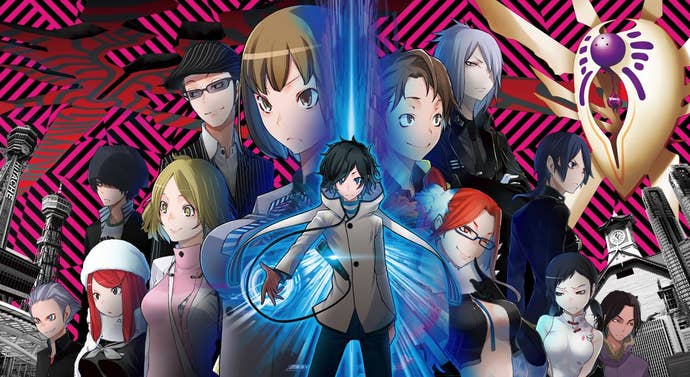
I find myself torn on the mechanics behind the combat in Devil Survivor 2. The basics of combat itself, built primarily around shifting Extra Turns and destroying foes with your four teams of three combatants, makes sense. The problem is team prep toes the line between complexity and excessive minutiae. You have your main cast, who participate in each battle alongside their chosen demons. Each of them leans in a specific direction - Jungo is mostly physical, Fumi is a magic cannon - but then you also have a host of skills you can equip or learn from the demons you fight. Think of them as each team's anchor.
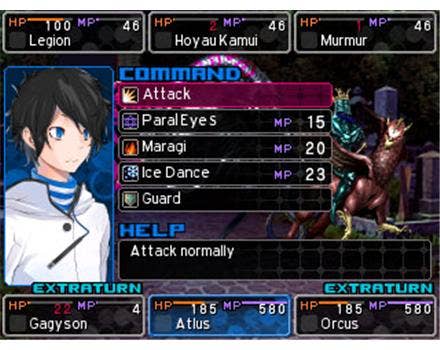
Then each character also has their assigned demon companions, which you can acquire via Demon Auction or Demon Fusion, both of which are entire worlds on their own. You'll find yourself spending hours in this loop of Auctions, Fusions, and Free Battles, testing your various team combinations, stealing new skills, and leveling up. You have a huge degree of flexibility in team composition, allowing you to create some insane groups, but I admit it may be a high wall for some players. It's not like Disgaea where these deeper systems exist, but can be ignored by neophyte players; Devil Survivor 2's high difficulty means you need to use every tool in your arsenal. Even on the lower Blessed difficulty, DS2 will throw some pain your way.
That said, we're not exactly swimming in great strategy RPGs these days, so anyone stepping up to take a shot at Devil Survivor 2: Record Breaker is probably ready to put in the work.
I think the best design decision in Devil Survivor 2 is the ongoing timer. Each event, outside of the grind-happy Free Events, costs 30 minutes in in-game time. You only have seven days to save the world. This means you have to make hard choices: which places do you go, which events do you take part in? Not only does this help the branching narrative, but it also gives the entire game a sense of urgency and pacing. Outside of team prep, the game can feel like it's screaming along to its conclusion. Time limits keep the game focused, which is good given everything that's available for you to do.
Record Breaker is good enough that I want to jump back and pick up Devil Survivor Overclocked, the re-release of the first game in the series. Does it require a lot of your attention just to skim through the main campaign? Yes. If you're not willing to put in that work, DS2 is not for you. That said, DS2 is a legitimately great strategy RPG, even if I feel it falls short of some of my favorites in the genre. It's worth a purchase for an strategy RPG fan.
InterfaceEasy to navigate, and MegaTen of course continues to set the industry standard for stylish-looking menus.
Lasting AppealIt's a pretty massive RPG, and this release is about 50% larger than the original version.
SoundMuch cleaner-sounding than on DS, and Shoji Meguro's new tunes in the Triangulum chapter sound great. And you can crank up or shut down the (English-only) voice work, as you prefer.
VisualsYou'll love or hate the ultra-anime character portraits, but the battlefield graphics are the best kind of old-school isometric sprites.
ConclusionRecord Breaker improves on the original version of Devil Survivor 2 in every respect. Anyone who passed it over the first time around, in the dying days of the DS, absolutely needs to give it a look. Veteran players should give it a thought, too, despite its premium price — the new material is substantial, and you can jump immediately into the Triangulum chapter. In all, this is a hefty and well-crafted RPG, and it puts a great spin on the time-tested rules of MegaTen.
